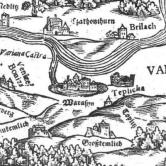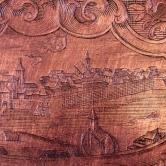History > Founding of the Town and the Middle Ages
There are no records of the exact date of establishing the Križevci borough, the parish, or the county. There are no archaeological or written sources on Križevci in the Middle ages. There are only some legends. The oldest monument related to the town is the old main altar of the Church of the Holy Cross dating from 1090.
Still, no records exist to confirm that the Church of the Holy Cross was built or consecrated in the same year, or that this was the year of founding of the town. Different historic documents and sources, as well as the mention of the year 1090, lead us to assume that Križevci had already existed as a settlement in the 11th century, or even earlier.An ancient legend takes us back to the days of king Coloman, when it was exactly Križevci, the most famous town of the medieval region of Slavonia, that the representatives of Croatia and Hungary chose as the meeting point for negotiating peace and dynastic union under the crown of Saint Stephan.
Stephan of the Gutkeled clan, the Banus of the entire Slavionia Region, north of the Križevci Citadel (castrum), set up the settlement (todayGornji grad (The Upper Town)), and on 24th of April, in 1252 he granted a Charter conferring a "New Royal Borough status" to Križevci- (novarum et liberam villam in Crisio). The Charter states that the Banus granted the Charter to serve and honour the King-(pro utilitete et honore regis), which actually means that the King had given his consent to issuing the chart. A year later, that is in 1253, King Bela IV of Hungary confirmed this civic privilege by issuing the famous Golden Bull.
When it comes to its geographical position, Križevci is closer to the center of the old region of Slavonia, that is North Croatia, than Zagreb or Varaždin. That is why the Banus often visited Križevci to resolve a dipute between the opposing parties, pass judgments, or grant charters and other documents. Križevci was also the seat of State Assemblies of Slavonian, later joined by Croatian, nobility, who discussed the issues related to their homeland, especially the issue of defense against the Turks. The most famous State Assembly is the one held in 1397. The Assembly was attended by the representatives of two opposing sides-King Sigismund of Luxembourg and his supporters on one side, and Banus Stephan with his adherents on the other. They started a row which ended in bloodshed. This Assembly became known as Križevci Bloody Assembly.




